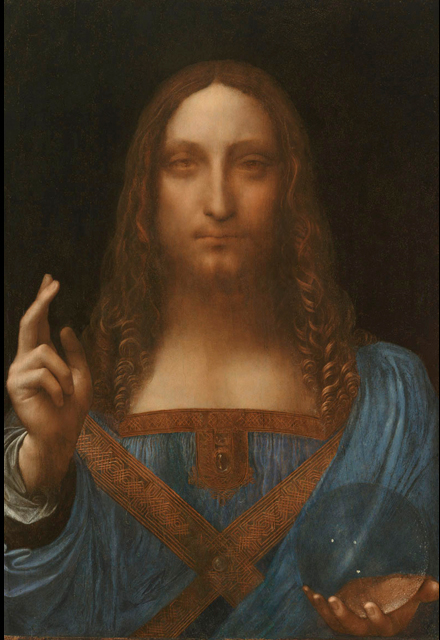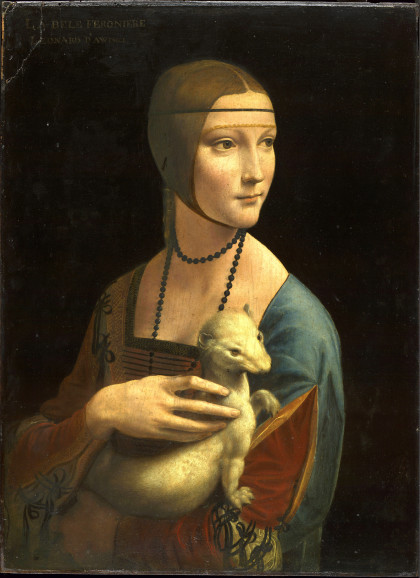 Next month, the National Gallery of London will display a "previously-unknown work by Leonardo da Vinci." Called Salvator Mundi (i.e. "Savior of the World"), the painting has been compared to surviving, fragmented preparatory drawings and undisputed paintings by da Vinci. As a result, many scholars believe it should be counted among a handful of paintings by the artist. Others doubt. The portrait of Christ will be on display in the exhibition Leonardo da Vinci: Painter at the Court of Milan, opening on November 9 in London, for everyone to compare and opine.
Next month, the National Gallery of London will display a "previously-unknown work by Leonardo da Vinci." Called Salvator Mundi (i.e. "Savior of the World"), the painting has been compared to surviving, fragmented preparatory drawings and undisputed paintings by da Vinci. As a result, many scholars believe it should be counted among a handful of paintings by the artist. Others doubt. The portrait of Christ will be on display in the exhibition Leonardo da Vinci: Painter at the Court of Milan, opening on November 9 in London, for everyone to compare and opine.
Anticipating certain and divisive scrutiny, Nicholas Penny, the Director of the National Gallery, says he is "pretty sure" it is by da Vinci. He was interviewed by The Sunday Times(London) for a feature in the paper's magazine titled "Leonardo? Convince Me.":
"It is a very weird picture." . . . It shares something, he says, with Leonardo's portraits The Lady with the Ermine and the Mona Lisa. "They respond, but hold something back. You can't think about them except in relationship to the viewer. They imply a narrative of which you are a part. That was not true of portraiture before Leonardo. The Salvator Mundi radiates intense presence. But because it's Leonardo you do wonder if you're going mad–and you certainly want people whose opinions you respect to look at it." He pauses. "People can judge for themselves." (Sunday Times Magazine. 9 OCT 2011.)
Before becoming Director, Mr. Penny was the Clore Curator of Renaissance Art at the National Gallery for ten years. He is a serious scholar; an expert. But, his advice here is nonsense. We may never be able to decisively attribute the painting to da Vinci–it has been over 500 years. But, we can certainly do better than stand in front of it to experience "radiated presence"–whatever that means–or take comfort in an "implied narrative." It is the kind of non-methodical, relativistic drivel that has made art history and art historians completely irrelevant to public debate in our evidence-based era.
I don't think Mr. Penny's advice in this interview is the basis for his opinions; but, he has been trained by a hundred years of art historical practice to talk to the public about art in an imprecise and unhelpful way. The Salvator Mundi painting has been through a host of scientific tests, including carbon dating and comparative chemical testing of pigments used in undisputed da Vinci paintings; and, a series of comparative stylistic studies, such as analysis of stroke and process. These are not the kind of tools available to average museum-goers who Mr. Penny invites to "judge for themselves." If he were a lawyer, we would expect him to say "Here is the compelling evidence for and against . . . therefore I am pretty sure it is attributable to da Vinci." not: "I'm pretty sure . . . It's weird . . . ask someone else." It is a sign of our times that a trained scholar and Director of one of the world's great museums would tell people to look at and interpret a Renaissance painting as though it were a 1960s drip painting. It is evidence of the public death of a way of talking about art called the "Morellian Method."
Giovanni Morelli (1816-1891) was a trained doctor who had a love of art. During his lifetime, royal and national museums sprung up throughout Europe. Many Old-Master works were placed on public display for the first time, leading to an international public dialogue on art not seen before or since. Competing for attention, these collections–sometimes of dubious origins– were often overzealous and sloppy in attributing works of art to marquee names. Paintings labelled "da Vinci" have since been downgraded to "School of da Vinci" or "Unknown Florentine Artist." At the time, art historians, critics and collectors were anxious to divide up painters into similar Schools (e.g. Spanish, French, Neopolitan) by observations of subject, palette and, even, size. Morelli had a different approach. He suggested that the same rigorous scientific methods used in medicine (e.g. dissection and observation) be applied to the observation of paintings. In particular, Morelli believed that an artist was best known by the minute and inconsequential parts of a painting: leaves on trees, fingernails, dirt. Artists didn't reveal themselves in the big things; but, in the mundane areas of their art that were not subject to constant reinvention. He wrote detailed treatises on the varied hand gestures of particular painters, contrasting them with others. Over time, he was considered a kind of Sherlock Holmes of painting.Though some of his attributions were incorrect, Morelli's object-based method pre-dated many scientific tools that his nineteenth-century philosophy would have embraced.
By the early twentieth century, paintings were interpreted differently. Art was considered mostly through philosophical arguments alone, not craftsmanship combined with philosophy. Morelli was not relevant to Dadaists or Pop Artists. But, it was my belief that thos, like Mr. Penny, who continued to study art in the Classical Tradition, would retain the rigor and language of a scientific method in order to understand, preserve and teach the public about these works. I think Mr. Penny has a deep understanding–many years beyond technical possibilities of Morelli's era–but his comments appear to indicate his lack of belief public capacity or interest to see paintings in a rigorous way. Maybe that is just my implied narrative.

